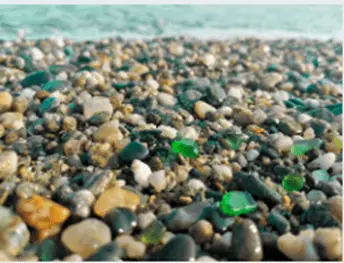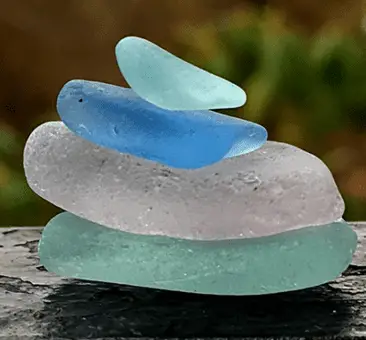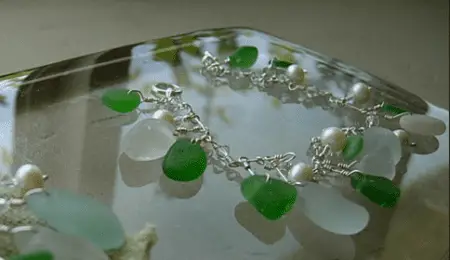
Sea Glass
Sea glass is the glass that is naturally found in the seashores and beaches. Sea glass is also sometimes called beach glass, sea gems, or sea pearls.
The real or genuine sea glass is formed from old glass bottles, jars, or other glass items disposed and washed off to the sea. These shards of glass may have reached the sea as waste, from shipwrecks, or any other human activity. Mostly, the waste pieces of glass come from commercials establishments selling juice, drinks such as beer, or companies that manufacture glassware. Over many years, these glass pieces get tumbled by waves, gravel, and sand in the sea. This way, the sea glass gets its color, texture, or appearance that is quite different from other man-made glass. The natural sea glass is considered more beautiful and valuable compared to man-made glass, especially when used in decorations or ornaments.
Figure 1: Sea glass seen in the beach
Image source: Pixabay
Characteristics of Sea Glass
Natural sea glass has many characteristics that make them unique and define their quality. This includes pores and texture, collection of frost on the surface, thickness and shape, color or presence of bubbles.
Pores and Texture
When you observe a sea glass under a microscope or magnifier, you can see small “c-shaped” pores or abrasions. These abrasions are formed as the glass undergoes uneven tumbling inside the sea over the sand, gravel, and water, and due to hydration over decades of exposure in saltwater. These pores are absent in man-made glass as the chemical processes used to make artificial glass leave no pores or abrasions on the glass surface. Also, in man-made glass, the machine used to tumble the glass is of uniform size, and it does not create any abrasions.

Image source: flickr.com
Frost on the surface
You can see the collection of frost or small water crystalline structures on the top of a sea glass.
This frost on the surface of a sea glass is the result of years of exposure to saline water under the sea. Due to this exposure to salinity, the structure of the glass breaks down and water leaches to the glass surface. This frost is not a salt residue but the result of the saline hydration process that happens in the sea over many years. The sea glass undergoes a natural hydration process. It becomes frosted as the sodium in the glass is replaced by hydrogen in the water.
In case, you have a piece of jewelry made of real sea glass, you can hide the frost by rubbing a drop of oil on its surface.
Figure 3. Bracelet made of Sea Glass

Some fake sea glasses get the frost outside by artificial processes such as tumbling and acid etching. Artificial process may not be able to give the same results, and only the real sea glass can have the frost seen on its surface. The water current and exposure to saline water ages the real sea glass and its quality is different from that of fake sea glass.
Thickness and shape
The older sea glasses have mostly thicker shape. Sea glasses also have curvature if they are part of old glass bottles. They don’t have a definite shape, nor are they very smooth or very hard.
Fake sea glasses can be thin or rough with uneven shapes that give them an appearance of real sea glass. Fake sea glasses may have designed shapes such as a carefully designed triangle or an oval shape. A fake sea glass may not get the real curvature seen in the piece of a sea glass formed from a shard of glass bottle. You can use these characteristics to differentiate a real sea glass from a fake one.
Color
Sea glasses are formed from very old pieces of glass (typically 20 years old or more). So, the colors seen in the sea glasses are mostly unique and may not be the same as seen in newer man-made glasses.
Time Required for the Formation of Sea Glass
The formation of sea glass is a natural and slow process. In this process, the amount of time plays the most crucial role. Typically, it takes around 20 to 30 years’ time to form good quality sea glass. This is because the natural chemical and physical changes to the glass within the sea are slower when compared to man-made artificial processes.
Difference between sea glass and beach glass
Sea glasses are found from the salty seashores, whereas beach glasses are found on the freshwater beaches or seawater beaches. Beach glass is a term that encompasses both sea glass and fresh-water beach glasses. While all sea glass comes under beach glass, not all beach glass is sea glass.
Salt-water sea glasses are more tumbled and weathered compared to fresh-water beach glasses.
The geographical locations where sea glass is commonly seen include the northeast United States, California, Mexico, Australia, and Italy. An example of a location to find fresh-water beach glasses is the Great Lakes in the United States.
Iris Glass
The Iris glass represents the vintage glassware from the 1930s produced by the American firm named Jeannette Glass Company. The glassware was originally known as Iris and Herringbone glassware. This glass was also called Iris glass or Iris crystal glass.
This glassware gets its name from the full-relief molded iris flowers with leaves on the main body of the glass, in the background of a fine-molded Herringbone pattern. There was a rayed-based pattern seen in the base of the glassware in all the productions. This rayed-based pattern is still used to identity the originality of the piece from the 1930s collection.
Figure 4. The Iris flowers seen in a Herringbone background in a typical Iris glass bowl
The Iris glass became very popular with many kinds of glassware available such as footed cocktail and dessert sets, dinner plates, bowls of all sizes, and flat tumblers. Sometime Iris glass was used along with metal as in a glass-and-metal-nut bowl. Or it was even used in the ruffled glass shades for ceiling fixtures.
History of Iris Glass
Jeannette Glass Company of Jeannette, Pennsylvania, produced the Iris and Herringbone glassware in 1928 and people used this glassware mostly in the Depression-era that followed. Hence, this glassware is also now known as Depression glass or Depression vintage glassware. Jeannette Glass Company existed from 1898 and continued to operate until 1983.
Design patterns in Iris Glassware
The Jeannette Glass Company produced different designs of Iris glass in the later years. These include the translucent Green and Pink 91/2″ Ruffled Salad Bowl or the Footed Creamer which were available only for a short period. These vintage Iris glass types are rare nowadays and are high-priced, if still kept intact without damage.
When the World War II ended, Jeannette Glass Company came up with the more popular “iridescent” finish in the Iris glassware. A special glaze, shade, and finish was given to the glass, and this was seen as a marigold shade in the glassware. This shade was seen in many items including 5″ cereal bowl, the smooth edge fruit bowl, or the 8″ luncheon plates.
By 1946, Iris glassware came with a new pattern—crystal decorated with Gold and Red—and was named Corsage. But this pattern was not a popular pattern. By the 1970s, Jeannette Glass Company produced more of their older design lines in different shades of red, yellow, blue, or green. An example of this Iris glass is the candy dish bottom which did not have the original “rayed” base pattern or covers.
Reproduction of Iris Glassware
Since the vintage Iris glassware became quite popular, there were efforts to reproduce the collection in 1999. This was particularly true about the 9” dining plate collection. It is possible to identity if the collection is original (from the 1930s), if you examine the base of the glassware for a specific pattern. The Iris glassware original production has a rayed-based pattern, that act as the signature to identify an original Iris and Herringbone glassware from a reproduced pattern in the later 1990s.
Source of Information about Iris Glassware
An excellent resource about Iris and Herringbone glassware is the American bestseller glass book, “Collectors Encyclopedia of Depression Glass” by Gene Florence, originally released in 1972.
Difference between Sea Glass and Iris Glass
1. Sea glass is typically old shards of glass seasoned in the seas due to natural chemical processes. They are man-made glasses that are naturally weathered. Iris glass are solely man-made glassware produced from the 1930s in America.
2. Sea glass is used mainly in decorations and in ornaments. Iris glass were used for making glassware such as tumblers, bowls, plates, etc., or in specific decorations such as ceilings.
3. Sea glass has a different quality when compared to Iris glass. Sea glass accumulates frost due to the chemical weathering it has undergone over the years. Iris glass is a man-made glass with the purpose of daily use, and hence it does not accumulate frost.

